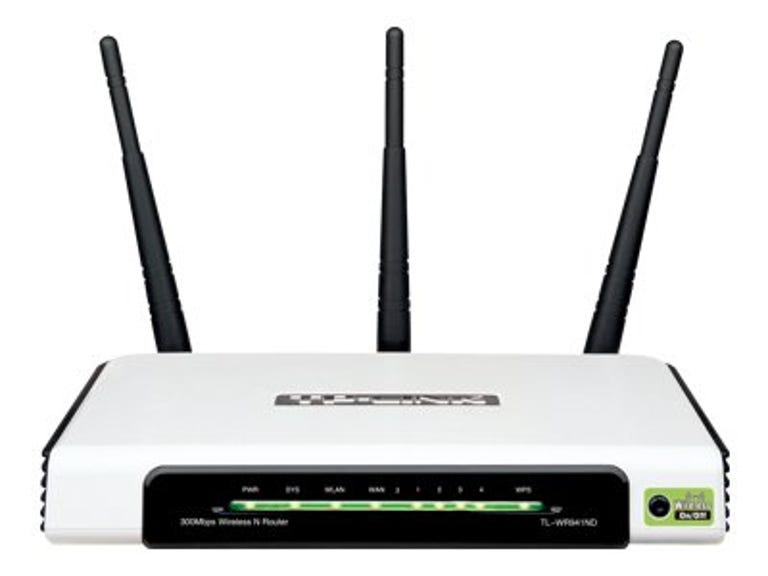 Why You Can Trust CNET
Why You Can Trust CNET TP-Link TL-WR941ND Wireless N Router review: TP-Link TL-WR941ND Wireless N Router
TP-Link TL-WR941ND Wireless N Router
The TP-Link TL-WR941ND Wireless N Router is a wireless router that supports the Draft N 2.0 specification and not much else. This means no network storage or dual-band support (the router works only in the 2.4GHz frequency), no print-serving capability, and no Gigabit Ethernet. The router doesn't even offer N-mode-only operation, in which Wireless-N routers can show off their N throughput speed without being interfered with by legacy clients. Instead, the TL-WR941ND works in mixed mode, where it supports both Wireless-N and Wireless-b/g clients. The TP-Link does, however, offer Wi-Fi Protected Setup, long-range, above-average throughput performance, and a stable signal. For about $60, the router is one of the most affordable Wireless-N routers on the market. For another $30 or so, though, we'd recommend the Linksys WRT310N, which has a much longer list of features and a better design.
The Good
The Bad
The Bottom Line
Design and ease of use
The TL-WR941ND has the typical design of a wireless router from a few years ago; it's a squarish box with three antennae on the back--crowding the network ports--and an array of LED blue indicator lights on the front. In its defense, however, the new, true dual-band D-Link DIR-855 has the same design, but with a slightly smaller footprint. Generally, we prefer a more compact design, with the antennae hidden inside the casing (or at least placed on the side), away from the ports, as with the Linksys WRT310N or the dual-band WRT610N.
The TL-WR941ND doesn't come with much. Inside the box you will find the router itself, a power adapter, a little Quick Installation Guide booklet, and a software CD that contains nothing but manuals of virtually every TP-Link router in PDF format. Nonetheless, it's easy to set it up by following the setup guide, and to configure the router using the Web interface. It took us just a few minutes to get the device up and running. Unlike the D-Link DIR-855 or the Linksys WRT310N, the TP-Link TL-WR941ND doesn't have a desktop setup application, so you'll need to stick with the Web interface.
Features
On the front, near the blue LED lights, the TP-Link TL-WR941ND features a Quick Secure Setup (QSS) button, which is essentially the push button for its Wi-Fi Protected Setup (WPS) feature. By pressing this button, you instigate a window of a few minutes where WPS-compliant clients can join the wireless network without you having to enter the encryption key--a simple, yet secure, method for adding clients to your network.
The TP-Link TL-WR941ND has four LAN ports and one WAN port. None of these ports are a gigabit port, which is disappointing for a Wireless-N router. It doesn't have a USB port, either. This means there are no USB-related features, such as print serving, attached storage, or Windows Connect Now, which would allow you to transfer the wireless encryption from the router to other clients using a USB thumb drive. Most other Wireless-N routers support at least some of these features, for example the D-Link DIR-655.
The router's Web interface is responsive, well-organized, and it somewhat resembles that of routers from Netgear. It could be more intuitive; after changing a setting, for example, a pop-up message appears saying you must restart the router before the change takes effect. The message, however, doesn't tell you what to do to restart the router, and so you will have to dig deeper into the menus to find out.
The TL-WR941ND offers all of the popular encryption methods for wireless routers, including WEP, WPA personal, and WPA enterprise. It also allows for assigning static IP addresses to any computers in the network , and it has a convenient port forwarding mechanism. This is very helpful in case you want to set up a computer in your LAN to host a special Internet service, such as an FTP or Web server.
Performance
We only tested the TP-Link TL-WR941ND on CNET Labs' mixed mode benchmark, and it registered 61.4Mbps--among the top four fastest on our most recent charts. On our long-range test, the router's throughput held up well, posting 56.5Mbps--the second-fastest time we've seen on this test. We wanted to test the router in N-only mode, but the router doesn't support this configuration. Instead, it must run in mixed mode supporting older 820.11b/g clients. Mixed mode is generally slower than N-only mode, though this does depend on the particular router. Still, if you have an older networking device that you don't plan on getting rid of soon, this TP-Link router offers great mixed-mode performance and can be had for a relatively paltry sum.
In addition, the router offered good range. We were able to pick up its signal and maintain a stable connection from around 300 feet away. In our testing environment, which is not range-optimized, Wireless-N routers that can offer 270 or more feet of coverage radius are considered to have very good range. The router also remained very cool during the entire testing process.
(Longer bars indicate better performance)
Service and support
TP-Link backs the TL-WR941ND with a one-year, parts-and-labor warranty. The company's technical toll-free support phone support can be reached 24-7 at 866-696-3962. At the company's Web site, you can find downloads for firmware and manuals, as well as FAQs on how to operate and configure the router.



